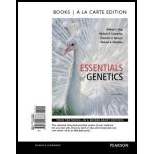
Concept explainers
To review:
The opinion about the access of databases of the genome, gene and protein sequences coupled with recombinant DNA (deoxyribonucleic acid) technology to only authorized persons, not to everybody.
Introduction:
Recombinant DNA technology (RDT) is a DNA-based technological application that uses living organisms and biological systems. RDT was started in the 1970s by Paul Berg, who made first recombinant DNA. The practice of scientists and researchers reach upto the development of genetically modified organisms that provide valuable products like high protein content through single cell protein and large-scale therapeutic protein formation (interferons, insulin hormones, and vaccine). An increase in applications of RDT may lead to cause an increase in mutagenic strain formation, multiple drug resistance in infectious agents of disease, etc.
Want to see the full answer?
Check out a sample textbook solution
Chapter 17 Solutions
Essentials Of Genetics (9th Global Edition)
- Although many cloning applications involve introducing recombinant DNA into bacterial host cells, many other cell types are also used as hosts for recombinant DNA. Why?arrow_forwardHow would you approach this problem? You plan to sequence the following DNA by Sanger sequencing. Your reaction includes your sequencing primer (5' is on the left) and template DNA (5' end is on the left), dNTPs, buffer, DNA polymerase and the following fluorescent ddNTPs: red ddGTP, green ddATP and blue ddTTP. Sequencing Primer: CCGCCGGGCCCCAT Template to be Sequenced: GAGCGGCGGGCTGAGTAGCTCGCCGCGGGGATGGGGCCCGGCGGATTarrow_forwardHi, I would like to know which program is used for the graphical presentation of the results of a meta-analysis of genome-wide linkage scans?arrow_forward
- 4.1. Recombinant DNA technology has had a dramatic impact on all aspects of molecular biology, allowing scientist to routinely study cells and their macromolecules in ways that were unimaginable. Describe manipulations central to this technology. (10) 4.2. Draw a diagram to illustrate a technique for creating clones of a particular DNA (DNA cloning).arrow_forwardHuman Genome ProjectIn 2003, the Human Genome Project was successfully completed, determining the exact sequence of the entire human genome, which is made up of 3 billion nucleotide base pairs. The data generated from the Human Genome Project is freely available online to anyone. Many pieces of research and innovations stemmed from the HGP, allowing the identifications of 1 800 disease genes. Many of the corporations using the results from the HGP are privately funded, and research is being done for profit even though the HGP results are provided freely. Identify one advantage and one disadvantage of corporate funding and patenting genetic research results.arrow_forward1- The following Wild Type DNA codes for color in a lizard living in the Namib Desert (tan sand) a skin colorof reddish brown. This lizard is preyed upon by hawks flying above.Wild Type (Normal) DNADNA Template Strand: TAC-TTC-AAA-CCG-ATTDNA (silent strand): ATG-AAG-TTT-GGC-TAA For number 7, compare this change to the wild type in number 1. Remember that the originalpigment is a different color.7. Let us assume that the following protein (Met-Lys-Phe-Ser) changes the pigment deposited inthe lizard skin to a tan color. Would this be detrimental? Would this be beneficial? Explaineither answer.arrow_forward
- LO 64- Explain how Next gen sequencing is applied in different technologies In which of the following scenario would it be best to use Next-gen sequencing? (select all that apply) a-To separate fragments of DNA based on their size- b-To insert a mutation at random in a gene c-To idently a novel pathogen d-To determine the nucleotide sequence of a microbe e- To insert methyl groups to cytosines in a DNA sequence asap pleasearrow_forwarda) What are vectors? Describe extensively the roles vectors play in genetic engineering? Write short notees on the following: Recombinant DNA, Cloning b) What are restriction enzymes? Describe extensively the roles restriction enzymes play in genetic engineering? Write short notees on the following: Selectable markers, Cloningarrow_forwardGenome comparisons have suggested that mouse DNA has mutated about twice as fast as human DNA. What is a possible explanation for this discrepancy? a. Mice are much smaller than humans. b. Mice live in much less sanitary conditions than humans and are therefore exposed to a wider range of mutation-causing substances. c. Mice have a smaller genome size. d. Mice have a much shorter generation time.arrow_forward
- Need help, please. 1) Which primer could be used as the forward primer, for synthesizing DNA from left to right in the above diagram? Enter the number of the primer here: 2) Which primer could be used as the reverse primer, for synthesizing DNA from right to left in the above diagram? Enter the number of the primer here: 3) Will these primers be part of the final PCR product? a.No, neither primer will be incorporated into the PCR product. b.The forward primer but not the reverse primer will be incorporated into the PCR product. c.The reverse primer but not the forward primer will be incorporated into the PCR product. d.Yes, both primers will be incorporated into the PCR product.arrow_forwardHow the Sequencing Technologies Have Progressed Rapidly ? Explain about this ?arrow_forward5. Which of the following alternative steps cannot be employed in the DNA extraction because it would cause denaturation of some DNA? a. Using vodka instead of isopropyl alcohol. b. Using warm isopropyl alcohol instead of cold isopropyl alcohol. c. Using ammonium chloride for the soapy salt solution instead of sodium chloride. d. Using unscented and uncolored liquid soap for the soapy salt solution 6. Which property of DNA makes it possible to wrap it around the toothpick? a. DNA has a double-stranded helical structure b. DNA is color white. c. DNA is made up of long and thin strands. d. DNA carries genetic informationarrow_forward
 Biology: The Dynamic Science (MindTap Course List)BiologyISBN:9781305389892Author:Peter J. Russell, Paul E. Hertz, Beverly McMillanPublisher:Cengage Learning
Biology: The Dynamic Science (MindTap Course List)BiologyISBN:9781305389892Author:Peter J. Russell, Paul E. Hertz, Beverly McMillanPublisher:Cengage Learning
